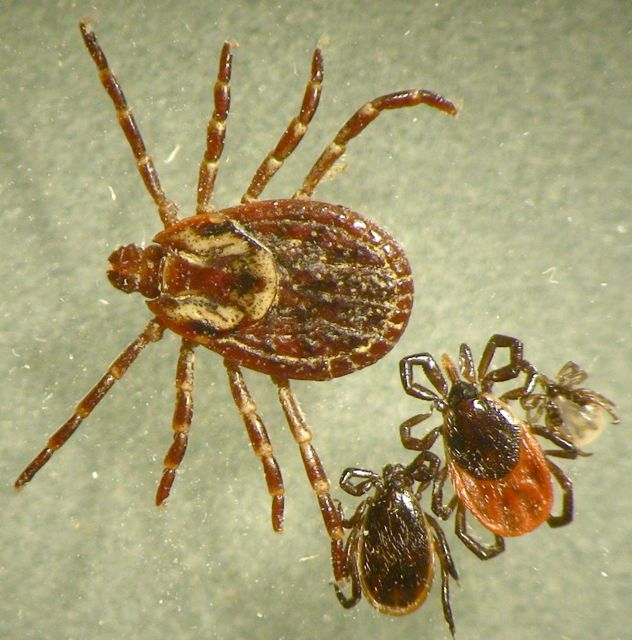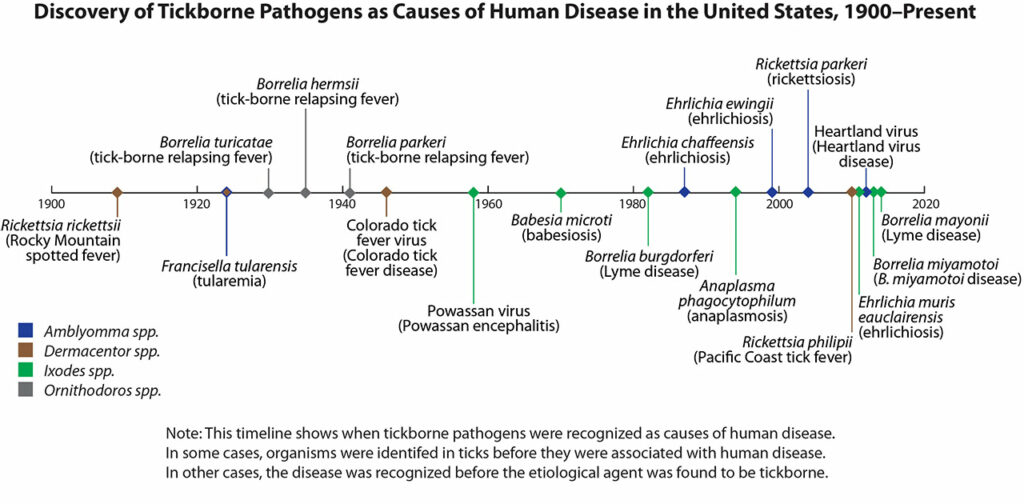Lyme and other tickborne diseases increasing according to CDC


Lyme and other tickborne diseases increasing according to CDC
May is Lyme Disease Awareness Month and this year it comes at a time when the Center for Disease Control (CDC) is urging people to be aware of the risks that can come with a tick bite.
According to the CDC, tickborne diseases increasingly threaten the health of people in the United States. The growing threat includes newly discovered disease-causing germs, an increasing number of reported tickborne illnesses, expanding geographic ranges for ticks, and a novel tick species found in the US. New tools for preventing tickborne diseases are urgently needed, and everyone should take steps to help protect themselves from tick bites.
“Tickborne diseases are on the rise and a public health priority. CDC has been working with state health departments to alert healthcare providers and the public about these diseases, equip state health laboratories to test for them, and to monitor their occurrence. New environmentally friendly control measures are needed, and we are working with researchers around the country to develop them. Prevention is key and taking steps to protect against tick bites should be on everybody’s radar.”
According to Lyle R. Peterson, MD, MPH – Director, Division of Vector-Borne Diseases, National Center for Emerging and Zoonotic Infectious Diseases.
New germs identified
Over the past two decades, seven new tickborne germs that can cause illness have been identified in the United States: Borrelia mayonii, Borrelia miyamotoi, Ehrlichia ewingii, Ehrlichia muris eauclairensis, Heartland virus, Rickettsia parkeri, and Rickettsia species 364D. New laboratory tests that look for DNA are finding new germs in ticks and people. CDC’s Advanced Molecular Detection (AMD) program has supported research to more broadly detect bacteria that may be causing illness in patients with suspected tickborne disease.

Reported cases increasing
In 2017, state and local health departments reported a record number of cases of tickborne diseases to CDC. The reported numbers of cases of Lyme disease, anaplasmosis/ehrlichiosis, spotted fever rickettsiosis (including Rocky Mountain spotted fever), babesiosis, tularemia, and Powassan virus disease all increased—from a total of 48,610 reported cases in 2016 to a total of 59,349 reported cases in 2017. Reported cases capture only a fraction of the overall number of people with tickborne illnesses. Even so, the number of reported cases of Lyme disease in the United States has tripled since the late 1990s.
Range expanding
The geographic range of some ticks that spread germs also continues to increase. One example is the lone star tick, which transmits the pathogens that cause ehrlichiosis, tularemia, and Heartland virus disease. The lone star tick continues to expand from its original territory in the southeastern United States into the northern and mid-western states.External The number of counties with the blacklegged ticksExternal responsible for most cases of Lyme disease, babesiosis, and anaplasmosis in the United States also has more than doubled over the past twenty years.
In addition, the number of counties in the northeastern and upper midwestern United States that are considered high-risk for Lyme disease increased by more than 300% between 1993 and 2012. CDC’s tick surveillance program is tracking changes in where ticks (and germs in ticks) are found to better understand when and where people are at risk for tick bites and tickborne diseases.
Aside from causing infections, recent studies in the United States and other countries suggest that ticks may play a role in causing an allergy to mammalian meat (alpha-gal allergy). CDC is working with healthcare providers and researchers to see if tick bites can cause alpha-gal allergy.
New tick species
A new tick species, Haemaphysalis longicornis (the Asian longhorned tick) has been identified for the first time in the United States. In other countries, bites from longhorned ticks can make people and animals seriously ill. As of April 9, 2019, no harmful germs have been found in the ticks of this species that have been collected in the United States. Research is ongoing.
Reasons complicated
While the exact reasons for the geographic spread of ticks and the diseases they carry are unclear, a number of factors may contribute. For example, the spread of Lyme disease over the past several decades has been linked to changes in land use patterns, including reforestation in the northeastern United States. Suburban development in these areas has increased the spread of these germs because people, ticks, deer, and tick hosts such as mice and chipmunks are in close contact.
Changing climate patterns can alter the natural environment and longstanding ecological relationships. Since vector-borne diseases have strong environmental links, we expect that changes in seasonality and location may occur. We don’t know what those changes will be, but we know that climate is only one of several very important factors that influence the distribution and occurrence of vector-borne diseases.
No sure way to predict
Predicting the number of Lyme disease or other tickborne infections, including how an upcoming season will compare with previous years, is complicated. Ticks that spread germs to people can have up to 2- to 3-year lifecycles, and many factors can affect their numbers, including temperature, rainfall, humidity, and the availability of hosts for the ticks to feed on, such as mice, deer and other animals. In any given year, the number of ticks in an area will be different from region to region, state to state, and even county to county.
Numbers of reported tickborne disease cases are also affected by healthcare provider awareness and by testing and reporting practices.
Know about risks in your area
According to a statement from the CDC, “We cannot easily forecast how severe each tick season will be. However, we do know that every year hundreds of thousands of people are bitten by ticks and get sick. Therefore, people should be aware that ticks could be in the areas where they live, work and play. Everyone should take steps to help protect themselves and their loved ones, including pets.”
While not all ticks spread the same germs, ticks can be found in every state. However, in the continental United States, some diseases occur more frequently in some areas than others:
- Reported cases of Lyme disease, anaplasmosis, babesiosis, and Powassan virus disease are concentrated in the Northeast, mid-Atlantic, and upper Midwest, with pockets of lower risk along the West Coast. The range of the tick that transmits Lyme disease also is expanding.
- Other serious tickborne diseases include Rocky Mountain spotted fever, ehrlichiosis, and Rickettsia parkeririckettsiosis. More than 60 percent of spotted fever rickettsiosis cases (including RMSF) occur in five states: Arkansas, Missouri, North Carolina, Oklahoma, and Tennessee.
Take steps to protect against tick bites
Taking steps to protect yourself and your family from getting a tick bite is the best defense against tickborne diseases. CDC recommends that people:
- Avoid areas with high grass and leaf litter and walk in the center of trails when hiking.
- Use Environmental Protection Agency (EPA)-registered insect repellentsExternalcontaining DEET, picaridin, IR3535, oil of lemon eucalyptus, para-menthane-diol, or 2-undecanone. EPA’s search toolExternalcan help you find the product that best suits your needs. Always follow product instructions.
- Use products that contain permethrin to treat clothing and gear, such as boots, pants, socks and tents or look for clothing pre-treated with permethrin.
- Treat dogs for ticks. Dogs are very susceptible to tick bites and to some tickborne diseases. They may also bring ticks into your home. Talk to your veterinarian about the best tick prevention products for your dog.
- Bathe or shower as soon as possible after coming indoors to wash off and more easily find crawling ticks before they bite you.
- Conduct a full-body tick check using a hand-held or full-length mirror to view all parts of your body upon returning from tick-infested areas. Parents should help children check thoroughly for ticks. Remove any ticks right away.
- Put dry clothes in a dryer on high heat for 10 minutes to kill ticks after you come indoors. If the clothes are damp, dry thoroughly and then tumble dry on high for 10 more minutes.








